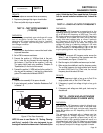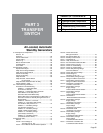
TRANSFER SWITCH
SECTION 3.1
DESCRIPTION & COMPONENTS
PART 3
Page 57
TRANSFER MECHANISM
The 2-pole transfer mechanism consists of a pair
of moveable LOAD contacts, a pair of stationary
UTILITY contacts, and a pair of stationary STANDBY
contacts. The load contacts can be connected to
the utility contacts by a utility closing coil; or to the
standby contacts by a standby closing coil. In addi-
tion, the load contacts can be actuated to either the
UTILITY or STANDBY side by means of a manual
transfer handle. See Figures 2 and 3.
STANDBY
LOAD
UTILITY
Figure 2. Load Connected to Utility Power Source
STANDBY
LOAD
UTILITY
Figure 3. Load Connected to Standby Power Source
UTILITY CLOSING COIL C1:
See Figure 4. This coil is energized by rectified util-
ity source power, to actuate the load contacts to the
UTILITY power source side. When energized, the coil
will move the main contacts to an “overcenter” posi-
tion. A limit switch will then be actuated to open the
circuit and spring force will complete the retransfer to
STANDBY. A bridge rectifier, which changes the utility
source alternating current (AC) to direct current (DC),
is sealed in the coil wrappings. If coil or bridge rectifier
replacement becomes necessary, the entire coil and
bridge assembly should be replaced.
STANDBY CLOSING COIL C2:
Coil C2 is energized by rectified standby source
power, to actuate the load contacts to their “Standby”
source side. Energizing the coil moves the load con-
tacts to an overcenter position; limit switch action then
opens the circuit and spring force will complete the
transfer action to “Standby”. This coil’s bridge rectifier
is also sealed in the coil wrappings. Replace the coil
and bridge rectifier as a unit.
LIMIT SWITCHES SW2 AND SW3:
Switches are mechanically actuated by load contacts
movement. When the load contacts are connected to
the utility contacts, limit switch SW2 opens the utility
circuit to utility closing coil C1 and limit switch SW3
closes the standby circuit to standby closing coil C2.
The limit switches “arm” the system for retransfer
back to UTILITY when the load contacts are con-
nected to the STANDBY side. Conversely, when the
load contacts are connected to the UTILITY side, the
switches “arm” the system for transfer to STANDBY.
An open condition in limit switch SW2 will prevent
retransfer to “Utility”. An open switch SW3 will prevent
transfer to STANDBY.
UTILITY
CLOSING
COIL (C1)
STANDBY
CLOSING
COIL (C2)
BRIDGE
RECTIFIER
BRIDGE
RECTIFIER
MANUAL
TRANSFER
LEVER
LIMIT
SWITCH
(SW2)
N1
N2
E2
E1
T1
LIMIT
SWITCH
(SW3)
T2
N2A A
A
B
126
205
B
E2
Figure 4. The “W/V-Type” Transfer Mechanism
TRANSFER RELAY
Transfer relay operation is controlled by a circuit
board. That circuit board is a part of a control panel
assembly, mounted on the standby generator set.
Figure 5 shows the transfer relay pictorially and
schematically. Relay operation may be briefly
described as follows:
1. Generator battery voltage (12 volts DC) is available to
the transfer relay coil from the generator circuit board,
via Wire 15B and Relay Terminal A.
a. The 12 volts DC circuit is completed through
the transfer relay coil and back to the generator
circuit board, via Wire 23.
b. Circuit board action normally holds the Wire
23 circuit open to ground and the relay is
de-energized.


















